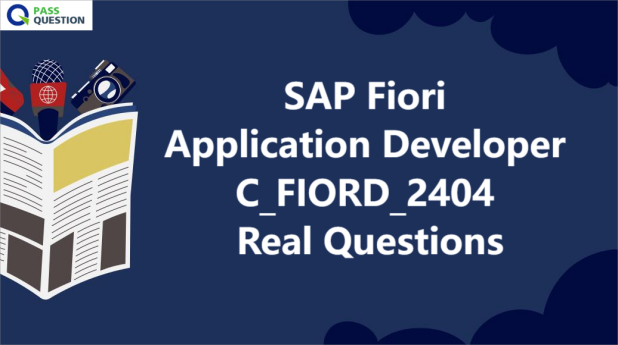SAP Fiori Application Developer C_FIORD_2404 Real Questions
Are you prepared for the C_FIORD_2404 SAP Certified Associate - SAP Fiori Application Developer examination? PassQuestion offers the most recent SAP Fiori Application Developer C_FIORD_2404 Exam Questions, tailored to enhance your preparation. These SAP Fiori Application Developer C_FIORD_2404 Real Questions are constantly updated to reflect the latest exam content and format changes, helping you understand the concepts and solutions thoroughly. Utilizing these SAP Fiori Application Developer C_FIORD_2404 Exam Questions can boost your confidence and enrich your understanding of the topics.

C_FIORD_2404 Exam Description - SAP Certified Associate – SAP Fiori Application Developer
This certification serves as a validation and proof that you have acquired the necessary skills in the field of SAP Fiori application development, specifically related to the Frontend Developer profile. By obtaining this certification, it demonstrates that you have not only gained the basic knowledge that a developer needs through formal SAP Learning training, but that you have also preferably honed these skills through practical experience within a SAP Fiori application development project team. The latter experience, ideally acquired in a mentored role, allows you to apply theoretical knowledge in a real-world context, further solidifying your understanding and expertise in this field. This certification is considered an entry level certification. As such, it provides a strong foundation for those interested in pursuing a career in SAP Fiori application development, acting as a stepping stone for future advancements in this area.
Exam Information
Exam Code: C_FIORD_2404
Exam Name: SAP Certified Associate – SAP Fiori Application Developer
Exam: 80 questions
Cut Score: 66%
Duration: 180 mins
Languages: English
Topic Areas
SAPUI5 Foundations 21% - 30%
SAP Fiori Elements & Smartcontrols 11% - 20%
Deployment & Testing 11% - 20%
SAP Fiori Architecture Overview <= 10%
SAP Business Technology Platform (SAP BTP) and SAP Business Application Studio <= 10%
OData and Advanced Data Handling <= 10%
Extensibility in SAPUI5 <= 10%
SAP Fiori Launchpad Configuration <= 10%
SAP Fiori Strategy, Standards, and Guidelines <= 10%
View Online SAP Fiori Application Developer C_FIORD_2404 Free Questions
1. You develop an SAPUI5 app that updates dat on the SAP back-end system. What activities are required when you implement an XSRF token? Note: There are 2 correct answers to this question.
A. Retrieve the token and send it with each write request
B. Execute the Refresh method for an expired token.
C. Include the token in the HTTP request body of each write request
D. Generate a token on each read and write request
Answer: A, B
2. In a SAP Fiori hub deployment, where is the SAPUI5 application code stored for a transactional app?
A. SAP Back-End Server (BES)
B. SAP Front-End Server (FES)
C. SAP HANA XS Engine
D. SAP Web Dispatcher
Answer: A
3. You are developing SAP Fiori Elements applications
Which of the following actions are available in SAP Web IDE?
Note: There are 2 correct answers to this question.
A. Create an annotation file associated with the OData service and add annotations
B. Add catalog to user menu in a PFCG role and grant the role to user
C. Create a catalog, target mapping, and tiles
D. Choose the OData service as data provider for the project
Answer: B,C
4. What options can you use to add UI annotations to a SAP Fiori Element Page? Note: There are 3 correct answers to this question.
A. Add Annotation to the Annotation file present as a part of WeblDE project using Annotation modeler
B. Add Annotations to the underlying CDS view
C. Add Annotation to the underlying Database Table
D. Add Annotations to the manifest file present as a part of WeblDE project using the Descriptor Edit
E. Add Annotation with the help of a Metadata Extension
Answer: B, C, E
5. You need the backend server to sort and filter the data used in your customer's app. Which SAPUI5-supported data model must you use?
A. ODataModel
B. ResourceModel
C. JSONModel
D. XMLModel
Answer: A
6. You need to securely connect the SAP Web IDE to an on-premise system. How does the SAP Cloud Connector help do this? Note: There are 2 correct answers to this question.
A. It creates connectivity by a reverse-invoke process on the on-premise system.
B. It supports custom destination API configuration and certificate inspection.
C. It secures an SSL tunnel between the SAP Cloud and the on-premise system.
D. It initiates a cloud-based reverse-invoke process.
Answer: A,C
7. What are the limitations of OPA5 test?
Note: There are 2 correct answers to this question.
A. It never causes a test to fail
B. Testing across more than one page is NOT possible
C. End-to-end tests are NOT recommended.
D. The developer needs to create the test during development
Answer: B,C
8. What are Technical Catalogs used for?
Note: There are 2 correct answers to this question.
A. To store tiles and target mappings by technology per solution area
B. To reference tiles and target mappings according to Segregation of Duties for example a Purchaser, a Buyer and so on
C. As a reference for Business Catalogs
D. As a reference for Business Groups
Answer: A,C
9. What is the purpose of the SAP Cloud Connector?
A. It connects the services of the SAP Cloud Platform and SAP Web IDE
B. It connects the services of the SAP Cloud Platform and on-premise systems in the customers' network.
C. It lists the search components and corresponding search models needed for the app.
D. It allows the SAP Web IDE to connect to the on-premise system's Cordova development environment
Answer: B
10. Why do you explore the Problem Space in detail during a Design Thinking workshop?
A. To create desirable solutions
B. To validate solution ideas
C. To understand user needs
D. To save costs in the evaluation phase
Answer: C
- TOP 50 Exam Questions
-
Exam
All copyrights reserved 2026 PassQuestion NETWORK CO.,LIMITED. All Rights Reserved.

